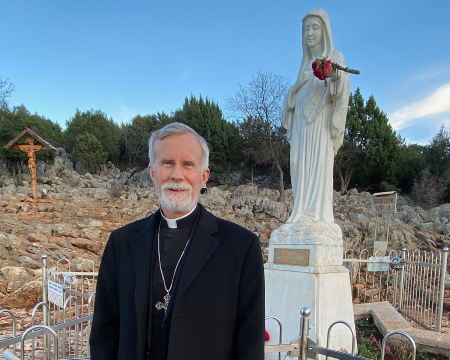 Hi readers, it seems you use Catholic Online a lot; that's great! It's a little awkward to ask, but we need your help. If you have already donated, we sincerely thank you. We're not salespeople, but we depend on donations averaging $14.76 and fewer than 1% of readers give. If you donate just $5.00, the price of your coffee, Catholic Online School could keep thriving. Thank you. Help Now >
Hi readers, it seems you use Catholic Online a lot; that's great! It's a little awkward to ask, but we need your help. If you have already donated, we sincerely thank you. We're not salespeople, but we depend on donations averaging $14.76 and fewer than 1% of readers give. If you donate just $5.00, the price of your coffee, Catholic Online School could keep thriving. Thank you. Help Now >
Tantum Ergo
FREE Catholic Classes
The opening words of the penultimate stanza of the Vesper hymn (see PANGE LINGUA GLORIOSI, II) of Corpus Christi. This stanza and the closing one, or doxology ("Genitori" etc.), form a separate hymn which is prescribed for Benediction of the Blessed Sacrament.
In private exposition, where permission has been obtained to give benediction with the pyx, the two stanzas are recited by the priest (or sung by a choir, if this is feasible: "si fieri potest, optandum est", says Van der Stappen). In other expositions they must always be sung. Customs vary in respect of the method of singing. In some places the choir sings the two stanzas; in others, the celebrant sings the opening words of each stanza, the choir continuing. The Ritual (Tit. IX, c.5) speaks of all the clergy present singing the stanzas, and Scholber (Caeremoniae missarum solemnium et pontificalium), commenting on this, suggests that either the celebrant and assisting clergy should intone the first line of the stanza, or the choir alone should sing both stanzas. A profound inclination of the head is made at the words "veneremur cernui" (Wapelhorst). The "American Ecclesiastical Review" (XXI, 1889, 644) points out that the rubrics do not prescribe an inclination of the head at the words "veneremur cernui", although the practice is frequent. Gardelllini, in his "Commentary on the Clementine Instruction" (XXIV, 9-10), cites the custom of the churches of Rome ; and the Rituals before his day make mention of the profound inclination at the Tantum ergo down to the word "cernui": "nam in verbo cernui completur dictionis sensus, qui inclinationem postulat". Authorities differ as to the time for incensing. Martinucci directs the placing of incense in the thurible before "Tantum ergo" and the incensing after "veneremur cernui". De Carpo suggests both either before "Tantum ergo" or after "veneremur cernui", according to the custom of the particular church. Wapelhorst, following De Herdt, directs that both take place with "Genitori" is intoned.
We ask you, humbly: don't scroll away.
Hi readers, it seems you use Catholic Online a lot; that's great! It's a little awkward to ask, but we need your help. If you have already donated, we sincerely thank you. We're not salespeople, but we depend on donations averaging $14.76 and fewer than 1% of readers give. If you donate just $5.00, the price of your coffee, Catholic Online School could keep thriving. Thank you.Help Now >
The "magnificent doxology " (W. A. Shoults in Julian, "Dict. Of Hymnol.") is a fitting climax to the great hymn. It borrows, however, the expressions "Genitori Genitoque" -- "Procedenti ab utroque, Compar" from a Pentecost sequence by Adam of St. Victor. Dreves, "Analecta hymnica", IV, 70, gives a sequence in honour of St. Agnes, in which occurs the stanza :
Genitori Genitoque,Psallat nostra concio;
Procendenti ab utroque
Compar sit laudatio;
Virginalis ipsum quoque
Laudet benedictio.
Of the musical settings, which are very abundant, the appropriate word must be one of caution in view of the direction of Pius X in his Instruction on Sacred Music (22 Nov., 1903, IV: "In the hymns of the Church the traditional form of the hymn is to be preserved. It is not lawful, therefore, to compose for instance, a Tantum ergo in such wise that the first trophe presents a romanza , a cavatina , an adagio , and the Genitori an allegro ." Singenberger, "Guide to Catholic Church Music" (St. Francis, Wisconsin, 1905), gives grade, voices, composer, etc., of more than six hundred setting of the "Tantum ergo" and the "Pange lingua", almost wholly of the German Cecilian School. Since 1903 many settings, also liturgically correct, have appeared by composers of other nationalities. The Vatican Graduale (1908) gives two plainchant melodies, or rather two forms of the same melody.
Neale, "Mediaeval Hymns and Sequences" (3rd ed., London, 1867, 178-81), discusses translations of the "Pange lingua", and speaking of the penultimate stanza, remarks that the lines: "Praestet fides supplementum Sensuum defectui" are "avoided by all" the four authors he mentions, and notes that " Caswall's translation, unshackled by rhyme, is nearest" to the original Latin: "Faith for all defects supplying, Where the feeble senses fail". Neale's own translation of this stanza is given, with slight alterations, in "Hymns Ancient and Modern" in the (Baltimore) "Manual of Prayers", and in the "English Hymnal". Some of the earliest translations of the two lines are: "And where our sense is seen to fail, There must faith supply restore" (Primer, 1604); "And faith with all, those wants supply Wherein the senses feel defect" (Primer, 1619); "Let faith in Jesus Christ supply, The senses' insufficiency" (Primer, 1685); "And faith for all defects supply, Whilst sense is lost in mystery all defects supply, Whilst sense is lost in mystery " (Primer, 1706). One of the most recent translations is that of the revised Husenbeth, "The Missal for the Use of the Laity" (London, 1903, 286): "Let us profoundly bend before This awful mystery, and adore ; Let types of former days give way, Like darkness at the blaze of day; And sense's failure be supplied By faith, our firm support and guide."
 Hi readers, it seems you use Catholic Online a lot; that's great! It's a little awkward to ask, but we need your help. If you have already donated, we sincerely thank you. We're not salespeople, but we depend on donations averaging $14.76 and fewer than 1% of readers give. If you donate just $5.00, the price of your coffee, Catholic Online School could keep thriving. Thank you. Help Now >
Hi readers, it seems you use Catholic Online a lot; that's great! It's a little awkward to ask, but we need your help. If you have already donated, we sincerely thank you. We're not salespeople, but we depend on donations averaging $14.76 and fewer than 1% of readers give. If you donate just $5.00, the price of your coffee, Catholic Online School could keep thriving. Thank you. Help Now >








 Daily Readings for Saturday, April 20, 2024
Daily Readings for Saturday, April 20, 2024 St. Marian: Saint of the Day for Saturday, April 20, 2024
St. Marian: Saint of the Day for Saturday, April 20, 2024 Children's Prayer For Parents: Prayer of the Day for Saturday, April 20, 2024
Children's Prayer For Parents: Prayer of the Day for Saturday, April 20, 2024

